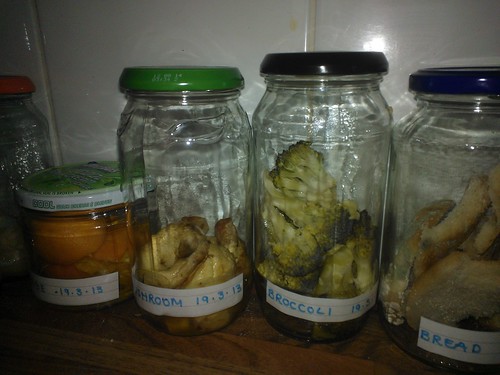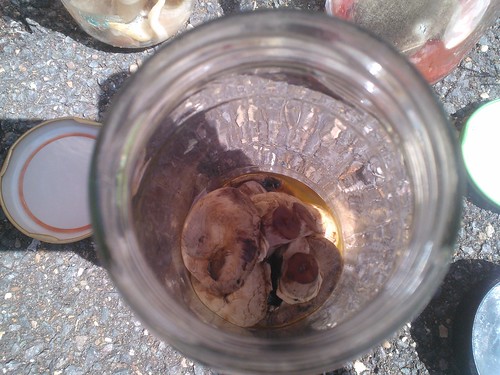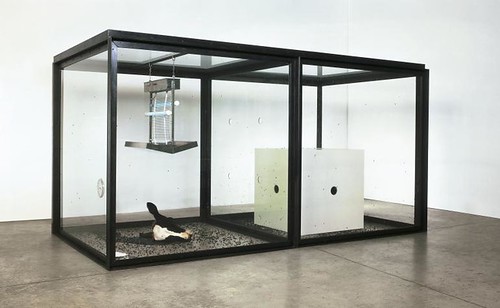Decomposition is regarded as a normal inevitable action in which certain elements can act as catalysts to speed the process along.
In the performance varied jars containing food will populate the space. These jars symbolise the aftermath of consumption. What exactly happens to food when you’ve chewed it, yes it’s been made smaller by your teeth but then what happens on its journey through your body? They’ll be scientists who can analyse the exact transformation but I’m interested in how this can be portrayed and become an integrated performance.
The breakdown of substances in the jar are getting reinforced by the sounds on the soundscape to create a sensory performance outlining the route and transformation of food in an extremely short space of time. The effects that have been added to original sourced sounds make the clips sometimes barely recognisable. As the materials change, whether it is the sound, props or environment, it will signify the constant decay and so representing a constantly changing performance environment. Having barely recognisable sound clips adds to the potential unknowing of the substance in the jar, depending on how long it has been rotting. This sense of the unknowing reinforces the fact that these materials and objects, which are apparent quite significantly in everyday life, can become extremely unfamiliar once transformed. Taking something that we have become comfortable with and then catalysing its transformation in to an unknown or unusual state can increase peoples’ awareness but also makes this performance real. These real and truthful elements of life are touching upon dangerous material which can be left unexplored, yet the exploration of this provides an educative and surreal situation for audience members and so enabling us to explore this material in a safe, controlled and visually simulated environment.
(the photographs above were taken by myself source: flicker)
The images above show the methodology of my approach and so show the transformation of some of the food in the jars. I used catalysts such as fresh air and sunlight to enhance the material and speed the process of decay. Some of them are more advanced them others depending on the dates which are all on the back of the jars. The collaboration of the different levels of deterioration is great to enable the audience to compare and analyse. The strangest thing about these jars is that when fresh food was situated inside it looked quite aesthetically pleasing and created a sense of glory and beauty, but as they started eroding, causing the material from the tops of the jars to crumble, they suddenly became less visually capturing. Concentrating this process allowed me to analyse the destruction on a steady basis enabling me to try and understand the reality of this development.
This cycled performance and overall narrative is the story of food progression. But this process when mixed with performative element creates dilemmas which has made the realistic narrative of this method slightly inaccurate and surreal. As you go through the soundscape a separate story is being expressed visually. This confusion links to the element of control discussed in my earlier posts and so the surreal ambiguity
(the photographs above were taken from http://miista.com/damien-hirst-putrid-profit/ source: flicker)
A Thousand Years by Damien Hirst he brings together a similar cycle, this time though, of life. He uses a dead cow’s head in a box with an Insect-O-Cutor hanging above. This very literal vision of life and death expresses the cycle so shockingly and again touch upon a familiar issue but the exploration has always been censored and limited by cultural attitudes. Similarly to my performance it includes quite literal material which could come across quite shocking and therefore unsettling. This notion of unsettlement occurs throughout my performance and has been a rooted influence and idea throughout my production process. This evident audience reaction has then been reinforced by the intimate relationship between the audiences and the jars of rotting food, alongside the disjointed and metaphorically ‘decomposing soundscape’.



